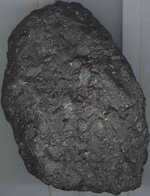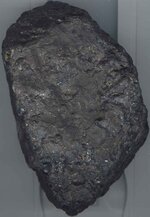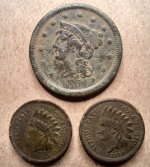JCinNJ
Full Member
I reposted this since I noticed I posted the same picture twice. My apologies.
Found this rock years ago at the beach on the Jersey Shore. Before I picked it up, I thought it was a piece of coal or a piece of jetty rock. It is way way heavier than coal and much heavier even than jetty rock. I had thought meteorite but it is not magnetic, does not read on a metal detector and has what appears to be small white crystals here and there on it. I have tried many times to break off a piece of it but could not get the smallest chip off it with a small sledge hammer. I am reluctant to even consider sending the whole rock to a geology department or lab. Although it apparently is not metal it sure feels like metal. It is a little smaller than a man's fist. I took geology 101, historical and environmental geology in college but that was long ago. I never thought of bringing in the rock to the class back then. And I have looked at a million pictures online and have not seen one that looks like this. I am assuming it is probably metamorphic or perhaps igneous but it certainly is not sedimentary.
Any comments appreciated.
Thanks & HH!
- joe
Found this rock years ago at the beach on the Jersey Shore. Before I picked it up, I thought it was a piece of coal or a piece of jetty rock. It is way way heavier than coal and much heavier even than jetty rock. I had thought meteorite but it is not magnetic, does not read on a metal detector and has what appears to be small white crystals here and there on it. I have tried many times to break off a piece of it but could not get the smallest chip off it with a small sledge hammer. I am reluctant to even consider sending the whole rock to a geology department or lab. Although it apparently is not metal it sure feels like metal. It is a little smaller than a man's fist. I took geology 101, historical and environmental geology in college but that was long ago. I never thought of bringing in the rock to the class back then. And I have looked at a million pictures online and have not seen one that looks like this. I am assuming it is probably metamorphic or perhaps igneous but it certainly is not sedimentary.
Any comments appreciated.
Thanks & HH!
- joe








